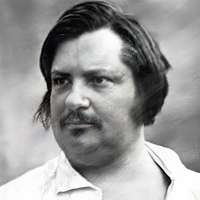Bailey Trela at the Paris Review:
 If I’d had to explain to myself why, with only three days to spend in Paris, I felt such an acute need to visit the home where Honoré de Balzac, a writer I wasn’t even that familiar with, had composed the bulk of The Human Comedy, a fictional project I’d barely even dipped my toes into, I’m not sure what I would have said. Probably it just seemed that if anyone would have had an interesting house, it would have been him. Open one of his novels at random, and chances are you’ll find a gratuitous description of a room and its furnishings, a flurry of signifiers that, today, can seem hard to place. Take Monsieur Grandet’s living room, for instance, as it appears in the opening chapter of Eugénie Grandet. We learn the room has two windows that “gave on to the street,” that its floor is wooden, that “grey, wooden panelling with antique moulding lined the walls from top to bottom,” that its ceiling is dominated by exposed beams. “An old copper clock, inlaid with tortoiseshell arabesques, adorned the white, badly carved, stone chimney-piece,” Balzac goes on. “Above it hung a greenish mirror, whose edges, bevelled to show its thickness, reflected a thin stream of light along an old-fashioned pier-mirror of damascened steel.” I don’t know what a pier-mirror is, and I couldn’t begin to differentiate an old-fashioned model from a sleeker, more modern one. In a sense, this feeling of being lost was part of the appeal of Balzac’s world as I’d imagined it.
If I’d had to explain to myself why, with only three days to spend in Paris, I felt such an acute need to visit the home where Honoré de Balzac, a writer I wasn’t even that familiar with, had composed the bulk of The Human Comedy, a fictional project I’d barely even dipped my toes into, I’m not sure what I would have said. Probably it just seemed that if anyone would have had an interesting house, it would have been him. Open one of his novels at random, and chances are you’ll find a gratuitous description of a room and its furnishings, a flurry of signifiers that, today, can seem hard to place. Take Monsieur Grandet’s living room, for instance, as it appears in the opening chapter of Eugénie Grandet. We learn the room has two windows that “gave on to the street,” that its floor is wooden, that “grey, wooden panelling with antique moulding lined the walls from top to bottom,” that its ceiling is dominated by exposed beams. “An old copper clock, inlaid with tortoiseshell arabesques, adorned the white, badly carved, stone chimney-piece,” Balzac goes on. “Above it hung a greenish mirror, whose edges, bevelled to show its thickness, reflected a thin stream of light along an old-fashioned pier-mirror of damascened steel.” I don’t know what a pier-mirror is, and I couldn’t begin to differentiate an old-fashioned model from a sleeker, more modern one. In a sense, this feeling of being lost was part of the appeal of Balzac’s world as I’d imagined it.
more here.
